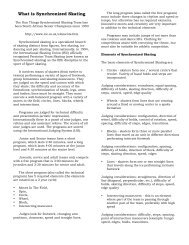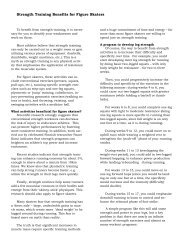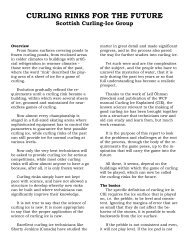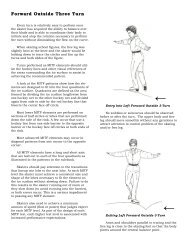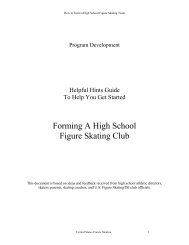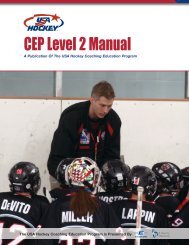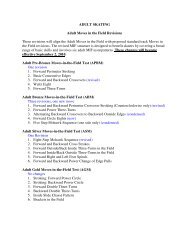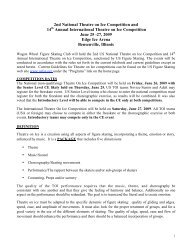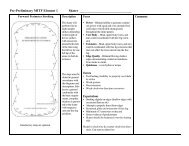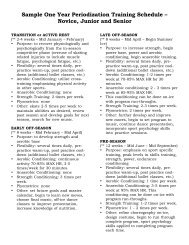CEP Level 3 Manual - Rushmore Hockey Association
CEP Level 3 Manual - Rushmore Hockey Association
CEP Level 3 Manual - Rushmore Hockey Association
You also want an ePaper? Increase the reach of your titles
YUMPU automatically turns print PDFs into web optimized ePapers that Google loves.
T A B L E O F C O N T E N T Said person should also be available. By assigningthese responsibilities to others, you will be able toconcentrate on the more immediate tasks ofcoordinating and conducting the sessions. A coachshould also have a minimum of two otherindividuals to assist with the on-ice sessions. A largenumber of assistants may be required depending onthe number of players in attendance.Arrive at the Rink EarlyAlthough proper planning should eliminatemost problems, it is advisable to arrive at the rinkwell in advance of the actual starting time. This willprovide you with ample time to check thateverything is in place and to answer any questionsfrom parents, players or your support staff. Sincemost of the administrative tasks have been assignedto others, you should also have time to review thetryout plan with your assistants and make any lastminute adjustments.Prepare the PlayersPrior to going on the ice, you should outline thetryout process to the players. This session shouldinclude the following information:• what player qualities you are looking for.• explanation of the drills to be run and theirpurposes.• objectives of scrimmage sessions.• target timeline for team selection.In addition, you should stress the importance ofstretching and a proper warm-up. The playersshould be led through a series of stretchingexercises in the dressing room or corridor and onthe ice. The first few ice sessions should include agood 15-20 minutes warm-up period to ensure thatplayers are physically ready to go through theevaluation drills and scrimmages without riskinginjury.Assigning Responsibilities for Player EvaluationThe third step in the player evaluation process isthe recruitment of other personnel to assist in theassessment of players.On-Ice AssistantsYou should have two or more on-ice assistantsto help conduct the tryout sessions. Theseindividuals can assist in player evaluation for specificpositions (forwards, defensemen, goaltenders), bycarrying out evaluation drills with small groups ofplayers. In drills involving a larger number, they canalso focus on specific individuals.Impartial ObserversAnother means of obtaining player assessmentinformation is to use “expert” observers in thestands who are assigned the task of rating players onspecific criteria. In addition to providing you with asecond opinion on borderline players, observerscan also be used to record more detailed playerassessment information for later analysis.Does a certain player win consistently against allother players? Where you have three relativelyequal players, is there one who comes out on top ofmost match-ups with the other two? If possible, tryto get a rating of every player at the end of eachsession.Coaching StaffIn the end, final decisions for player selectionrest with you the coach. In some cases you may befamiliar with a number of players, having observedthem in previous seasons. Such prior information,combined with player assessments from observersand on-ice assistants, is invaluable. However, it isalso essential that you create opportunities foryourself during try outs to screen and evaluate allplayers as effectively as possible.Although it is probably more efficient to assessplayers from the stands since this usually affords awider view of the various drills and scrimmages, youshould also spend some time on the ice in order toget closer to the action and observe some of themore subtle aspects (i.e., emotional characteristics,passing and receiving skills, soft hands in handlingthe puck and the ability to understand instructions).As a general guideline, however, you should spendconsiderably more time observing from the standsduring the player selection period.Releasing PlayersOnce decisions have been made regarding therelease or cutting of players during the tryoutperiod, you must have a plan for informing theseplayers. Although the details of this plan will varyfrom coach to coach, and will depend to someextent on the age level of the players, the followingguidelines should be adhered to as much aspossible.Avoid Public AnnouncementsDo not post a list of player cuts or read thenames of players to be released, in front of the restof the team. Instead, whenever possible, you shouldtry to take individual players aside briefly towardsthe end of the session and ask them to meetprivately with you afterwards.Speak with the Player IndividuallyTalk to each player individually and brieflyexplain the player’s weaknesses as well as pointingout some strengths. Be honest and straightforward.Invite Questions from the PlayerProvide the player with an opportunity to askfurther questions about the evaluation. In additionto helping you select the team, a major objective ofthe evaluation process should be to provide theplayer with constructive feedback to guideimprovement.Direct the Player to Another TeamIf your association has teams at other levels ofcompetition, ensure that released players areprovided with a schedule of their tryouts. Ideally,the coach of this team should also be at the arena inorder to personally meet the players. Where nosuch tiering system exists, you should make theplayer aware of whatever options do exist (i.e.,recreational league, school league).Leave on a Positive NoteThank the player for participating in the teamtryouts and encourage the individual to continueworking to improve in areas of weaknesses.6 | USA <strong>Hockey</strong> Coaching Education Program <strong>Level</strong> 3 <strong>Manual</strong>Role of the Coach | 7



